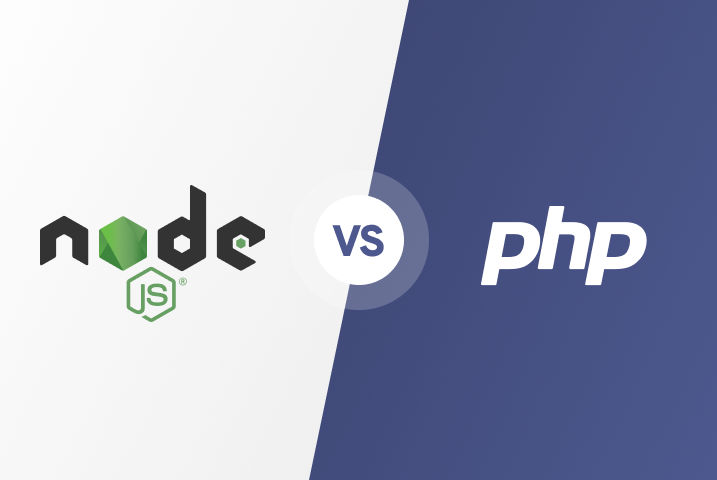Introduction
In custom software development, choosing the tech stack at the beginning of each project is a fundamental part. In this article, we would like to compare the two old fellows in backend development: Node JS vs PHP. This comparative study compares these two platforms in-depth, exploring their unique architectures, features, performance features, and suitability for various use cases.
NodeJS has garnered significant attention for its approach to modern JavaScript features on the server side. Built on the V8 engine, NodeJS employs an event-driven, non-blocking I/O model. It excels in scenarios demanding high concurrency and real-time web application development applications. Its single-threaded architecture and asynchronous programming enable remarkable efficiency benefits in handling concurrent connections.
On the other hand, cases of PHP in 2023 have been a driving force behind countless websites and traditional web applications for over two decades. It is known for its simplicity and robust support for web-related tasks. PHP has become a mature and widely adopted language. Its synchronous, blocking I/O model and ability to create multiple threads make it well-suited for CPU-intensive tasks and traditional backend development workloads.
As the demand for high-performance, scalable, and responsive traditional web applications rises, choosing asynchronous programming between NodeJS and PHP becomes crucial. This detailed comparison of each backend framework analyzes its strengths, weaknesses, performance, database integration abilities, and Amazon Web Services (AWS) support.
NodeJS Overview

NodeJS is an open-source, cross-platform JavaScript runtime environment that executes JavaScript development outside a web browser. It was initially released in 2009 by Ryan Dahl and has since gained immense popularity due to its ability to handle server-side operations efficiently. NodeJS is built on top of the V8 JavaScript engine, the same engine used by Google Chrome, allowing developers to write server-side applications using JavaScript.
Amazon Web Services (AWS) provides robust support for NodeJS through various services and tools. AWS Lambda, a serverless computing platform, allows developers to run NodeJS functions without provisioning or managing servers. AWS Elastic Beanstalk, a fully managed service for deploying and scaling web applications, offers seamless integration with NodeJS applications. The pros and cons of both technologies are given below:
Features and advantages of NodeJS
Asynchronous and Event-Driven
NodeJS follows an event-driven, non-blocking I/O model, which makes it highly efficient in handling concurrent connections and real-time applications. This architecture allows NodeJS to handle multiple client requests without creating additional threads, improving performance and scalability. The event-driven approach enables Node.js to respond to events as they occur rather than waiting for a specific operation to complete.
When a request is made, NodeJS registers a callback function. Once the operation is complete, it will be executed, freeing up the event loop to handle other incoming requests or events. This non-blocking behavior ensures that the application remains responsive and can efficiently manage many concurrent connections without getting bogged down by blocking operations.
Single-Threaded and Non-Blocking I/O
NodeJS employs a single-threaded event loop architecture, which processes all incoming requests and events non-blocking using the non-blocking I/O model. This approach avoids the overhead of thread creation and context switching. It leads to better resource utilization and execution speed, application speed, and page load speed.
The event loop continuously monitors incoming events and executes the corresponding callback functions associated with those events. Using a non-blocking I/O model and a single thread, NodeJS eliminates the need for complex synchronization mechanisms. It reduces the risk of race conditions and other concurrency-related issues that can arise in multi-threaded environments.
The non-blocking I/O model also allows for efficient handling of I/O operations. It includes network requests or file system operations without tying up the event loop. This results in more efficient utilization of system resources and improved overall application performance.
Cross-platform and Universal JavaScript
One of the key advantages of NodeJS is its ability to use JavaScript for non-blocking I/O models and client-client and server-side development. This allows developers to leverage their existing stack javascript development knowledge, promote js code reuse, and maintain a consistent codebase across the entire application stack.
Using a single programming language for an application's front-end and back-end components. It allows developers to share code between the two environments, reducing duplication and facilitating better team collaboration.
Additionally, the universality of JavaScript in NodeJS. It enables the creation of universal applications where the same codebase can be executed on both the server and the client. It leads to improved performance and simplified development workflows.
Large Ecosystem and Community
NodeJS overview and benefits from a thriving ecosystem of open-source packages and libraries facilitated by the Node Package Manager (npm). This vibrant community contributes to the rapid development and adoption of new tools, frameworks, and best practices. It ensures that NodeJS stays up-to-date with the latest trends and technologies. The npm registry offers an extensive collection of reusable modules. It ranges from low-level utilities to full-fledged frameworks. It enables developers to leverage existing solutions and accelerate their development process.
The active community around NodeJS also provides valuable resources, such as tutorials and forums. The developers can seek guidance, share knowledge, and collaborate on projects. This strong ecosystem and community support contribute to NodeJS's growth and ongoing improvement of NodeJS. This makes it attractive for developers looking to build robust and scalable applications.
Let's take a look at the statistics of Node JS communities as of the beginning of January 2024:
Github: Node has 101k (96,7k was in July 2023) stars from Node JS developers
Reddit: node community has 252k (235k was in July 2023) thousand users,
StackOverflow: 469,819 (465,134k was in July 2023) in questions tagged [nodejs],
Twitter: 870,8K (860.6K was in July 2023) followers of NodeJS.
Do you need support with your NestJS and NodeJS backend app?

Disadvantages of NodeJS
Not Suited for CPU-Intensive Tasks
Due to its single-threaded nature, NodeJS may not be optimal for CPU-intensive tasks such as video encoding, data compression, or scientific computations. These function client-sent-s can block the event loop, causing performance bottlenecks and potentially degrading the overall application responsiveness.
Callback Hell and Asynchronous Programming Complexity
While NodeJS's asynchronous programming model offers performance benefits, it can also lead to complex code structures, often called "callback hell." This can make code more challenging to read, maintain, and debug, especially as complex applications need to be revised.
Potential Performance Issues with the Single-Threaded Model
Although NodeJS excels in handling concurrent connections, its single-threaded model may need to be revised. It deals with intensive tasks or scenarios that require heavy CPU utilization. In such cases, developers may need to employ techniques like clustering or worker threads to mitigate potential performance bottlenecks.
PHP Overview

PHP (Hypertext Preprocessor) is a scalable server-side purpose scripting language primarily used for web development. It was first released in 1995 and has become one of the most widely adopted languages for building dynamic web applications. PHP is known for its simplicity, ease of use, and robust support for web-related tasks. It includes handling forms, generating dynamic content, and interacting with databases.
Amazon Web Services (AWS) provides extensive support for PHP through various services and tools. AWS Elastic Beanstalk simplifies the deployment and management of PHP applications, while AWS Lambda allows developers to run PHP functions in a serverless environment. Additionally, AWS offers optimized PHP runtimes and integrations with popular PHP project frameworks and libraries. The advantages and disadvantages of PHP are given below:
Features and advantages of PHP
Mature and Widely Adopted
PHP is a mature language that has been around for over two decades, with its roots dating back to 1994. Throughout its long history, PHP has continuously evolved and adapted to the changing web development needs. It facilitates its position as one of the most widely adopted server-side scripting languages. Millions of websites and web applications are powered by PHP, ranging from small personal blogs to large-scale enterprise systems. This widespread adoption has fostered the growth of a vast ecosystem of tools, libraries, and community support.
Developers can leverage many open-source and commercial PHP frameworks. The popular cms platform is called Content Management Systems (CMS). The third-party libraries streamline the development process and enable the creation of robust and feature-rich web applications.
Easy to Learn and Get Started
One of the key strengths of PHP is its gentle learning curve. The language's syntax and access are straightforward to grasp, especially for developers with experience in other C-style languages like C, C++, or Java. PHP's simplicity and clear documentation make it an accessible choice for beginners and experienced developers of out-of-the-box tools. With its intuitive approach to common web development tasks, such as handling forms, managing sessions, and interacting with databases, PHP allows developers to become productive. It starts building functional web applications quickly. The language's low barrier to entry has contributed to its widespread adoption and the growth of its vibrant community.
Strong Server Support for Web Backend Development
PHP was designed for web development, offering robust support for various web-related tasks. The language provides a rich set of built-in functions and libraries tailored for web development. It eliminates the need for complex third-party dependencies in many cases. PHP offers a comprehensive set of out-of-the-box tools, from handling forms and sessions to interacting with databases and managing file uploads. Additionally, PHP seamlessly integrates with popular web technologies like HTML, CSS, and JavaScript, enabling developers to build complete and dynamic web applications. The language's tight integration with web servers, such as Apache and Nginx, further enhances its suitability for web development tasks.
Large Community and Ecosystem
PHP benefits from a vast and active community of developers, contributors, and enthusiasts. This vibrant community has played a crucial role in the language's growth and evolution. It contributes to developing numerous open-source frameworks, libraries, and tools. Popular PHP frameworks like Laravel, Symfony, and CodeIgniter have thriving communities. It offers comprehensive documentation, tutorials, and support resources.
The PHP community ensures a constant flow of new libraries, plugins, and resources, enabling developers to leverage existing solutions and accelerate their development process. Additionally, the community provides opportunities for knowledge-sharing, collaboration, and networking through online forums, meetups, and conferences. It speeds up a supportive environment for developers at all skill levels.
Let's take a look at the statistics of PHP communities as of the end of March 2024:
Github: PHP has 37,1k stars from PHP developers
Reddit: php community has 168k thousand users,
StackOverflow: 1,464,077 in questions tagged [php],
Twitter: 110,5K followers of PHP.
Disadvantages of PHP
Synchronous and Blocking I/O
Unlike NodeJS, PHP is a side programming language that follows a synchronous and blocking I/O model, meaning each request is handled sequentially. This can lead to performance limitations, especially in high concurrent traffic or long-running operations scenarios. Requests may need to wait for previous ones to be completed.
Performance Limitations for Large-Scale Applications
While PHP performs well for small to medium-sized web applications, it may face scalability challenges when dealing with large-scale, high-traffic applications. This is primarily due to its synchronous nature and the overhead associated with spawning new processes or threads for each request.
Inconsistent Coding Standards and Language Quirks
PHP has evolved, and this evolution has introduced some inconsistencies in coding standards and language quirks. These inconsistencies can make it challenging for developers to write maintainable and readable code, especially when working on larger projects or collaborating with teams.
Performance Comparison between NodeJS and PHP
The head comparison overview regarding performance, both NodeJS and php comparison have strengths and weaknesses, depending on the application's specific use case and requirements. Table 1 shows the tabular comparison of the performance of NodeJS and php comparison table.
Table 1: Performance Comparison between Node.js vs. PHP
Aspect | Node.js | PHP |
Architecture | Event-driven, non-blocking I/O model with a single-threaded event loop. | Synchronous, blocking I/O model with the ability to create multiple threads or processes for concurrent request handling. |
Concurrency Model | Handles concurrent connections efficiently using an event loop and asynchronous programming. | It relies on thread- or process-based concurrency, which can be more resource-intensive. |
Scalability | Highly scalable for applications with many concurrent connections and real-time requirements. | Scalability can be challenging for large-scale, high-traffic applications due to the overhead of creating new threads or processes. |
Performance (CPU-bound tasks) | It is not optimized for CPU-intensive tasks due to its single-threaded nature. This can lead to performance bottlenecks. | It is better suited for CPU-intensive tasks as it can leverage multiple threads or processes. |
Performance (I/O-bound tasks) | Excels in handling I/O-bound operations like network and disk I/O due to the non-blocking architecture. | I/O operations can block the execution, leading to potential performance bottlenecks, especially under high concurrency. |
Database Integration | It supports various databases through object-relational mapping (ORM) libraries like Sequelize and Mongoose and direct database drivers. | Robust database integration with built-in functions and libraries for popular databases. It also supports mighty ORMs like Doctrine and Eloquent. |
Ecosystem and Community | A large and rapidly growing ecosystem with many open-source packages available through npm (Node Package Manager). Active and vibrant community. | A mature and well-established ecosystem with a large number of libraries and frameworks. Extensive community support and resources. |
Learning Curve | Requires understanding of asynchronous programming and event-driven architectures, which can have a steeper learning curve. | It is relatively more straightforward to learn and get started with, especially for developers with experience in other C-style languages. |
Use Cases | Well-suited for real-time applications, microservices, streaming applications, and scenarios with high concurrency. | They are widely used for traditional web development, content management systems, e-commerce platforms, and general-purpose web applications. |
Do you need support with your NodeJS backend development efforts?

Database Integration
NodeJS vs. PHP: both programming languages give an equal opportunity to integrate with all possible databases. The most resolved databases for these languages are those that allow for the reduction of the threat of attacks – running them in a SAFE mode.
NodeJS
NodeJS supports integrating various databases through Object-Relational Mapping (ORM) libraries like Sequelize, Mongoose (for MongoDB), and direct database drivers. This allows developers to interact with databases using JavaScript seamlessly.
In general, NodeJS fits all types of databases, and it depends on the complexity and goal of your program. It works well with not only SQL databases or NoSQL and graph databases, such as Towb MongoDB and CouchDB but also with graph database sysCouchDBtems, such as Neo4j. NoSQL injection attacks are a common risk. They are more numerous than SQL injection since SQL code structure makes it inherently less prone to such attacks.
PHP
PHP has robust support for database integration, with built-in functions and libraries for connecting to popular databases such as MySQL, PostgreSQL, and SQLite. Additionally, PHP offers powerful ORMs like Doctrine and Eloquent (Laravel's ORM), providing an abstraction layer for database operations.
PHP utilizes relationships with traditional/relational databases such as MySQL, MariaDB, Db2, MongoDB, Oracle, PostgreSQL, and SQLite. However, MySQL database is mostly used with PHP. MySQL is SQL-compliant and presents numerous benefits.
It’s easy, extremely powerful, fast, secure, and horizontally scalable. Furthermore, MySQL runs on platforms like UNIX or Linux, Microsoft Windows, Apple Mac OS X, etc.
Amazon Web Services Support
Both NodeJS and PHP enjoy extensive support from Amazon Web Services (AWS), one of the leading cloud computing platforms. AWS provides a wide range of services and tools that enable developers to deploy, scale, and manage their applications easily in the cloud. It can leverage the power and flexibility of AWS's robust infrastructure.
NodeJS
AWS offers comprehensive support for NodeJS applications, catering to various deployment models and use cases. One of the key services for NodeJS developers is AWS Lambda. It is a serverless computing platform that allows developers to run NodeJS functions without provisioning or managing servers.
With AWS Lambda, developers can focus on writing code and leverage automatic scaling, high availability, and a pay-per-use pricing model. Additionally, AWS Elastic Beanstalk simplifies the deployment and management of NodeJS applications. It provides a fully managed service for deploying and scaling web applications and services.
Developers can easily deploy their NodeJS applications with just a few clicks or commands and Elastic Beanstalk. It handles capacity provisioning, load balancing, and application health monitoring.
Furthermore, AWS CodeDeploy enables automated deployments of NodeJS applications to various compute services, such as Amazon EC2 instances or AWS Lambda functions. This service streamlines the deployment process, reducing downtime and ensuring consistent and reliable application updates.
AWS also offers services like Amazon ElastiCache (for caching) and Amazon DynamoDB (for NoSQL databases). These services integrate with NodeJS applications, providing developers with the tools to build scalable, high-performance applications.
PHP
AWS provides robust support for PHP applications, enabling developers to leverage the full power of the AWS ecosystem. AWS offers optimized PHP runtimes that are regularly updated with the latest security patches and performance enhancements, ensuring developers can confidently build and deploy PHP applications.
Additionally, AWS Lambda supports PHP functions, enabling developers to build and run serverless PHP applications that scale based on incoming traffic. This serverless computing model allows developers to focus on writing php code without worrying about managing servers or infrastructure.
AWS integrates seamlessly with popular PHP frameworks and libraries, such as Laravel, Symfony, and WordPress, providing developers with a familiar and productive development environment.
Amazon Relational Database Service (Amazon RDS) and Amazon ElastiCache offer robust database and caching solutions, enabling developers to build high-performance and scalable PHP applications.
By leveraging AWS's extensive support for NodeJS and PHP, developers can easily use various services and tools to build, deploy, and scale their applications.
When to Choose Node.js Over PHP?
If you are looking for the following features, you can receive optimal value for your web app development from NodeJS.
Developing Efficiency – When creating a dynamic single-page application, you may use performance MongoDB, ExpressJS, or ReactJS. The latter stack is commonly complimented with NodeJS for ease of development and performance fulfillment.
High-speed and Consistent Callback from Servers – NodeJS supports web applications that consist of server requests that have used the servers. Thanks to its asynchronous execution that operates in a non-blocking way, this becomes possible. Therefore, if your project needs speed, NodeJS is your answer.
Real-Time Data – If the data transmission speed from the server to the client-side application is at its best. The NodeJS application is simple for the real-time data-reliant data-reliant web application. The companies such as Netflix, LinkedIn, Quora, and Medium have used NodeJS for quite a while. You can detect the connecting thread among the three.
Future Outlook
As we look ahead, NodeJS and PHP continue to evolve and grow, propelled by their active communities and ongoing development efforts. NodeJS is experiencing increasing adoption across various industries and sectors. It is fueled by its ability to handle real-time applications, microservices architectures, and the growing demand for isomorphic (universal) JavaScript applications.
The NodeJS ecosystem is constantly expanding, with new features, libraries, and frameworks being introduced regularly to enhance developer productivity and address emerging use cases. As the need for scalable and high-performance web applications continues to rise, NodeJS is well-positioned to meet these requirements with its non-blocking, event-driven architecture.
On the other hand, the PHP project remains a popular choice for web development, and a large and active community contributes to its growth and evolution. PHP continues to receive updates and improvements, with new versions introducing performance enhancements, better security features, and modern language constructs.
Popular PHP frameworks like Laravel, Symfony, and CodeIg niter continuously evolve, providing developers with robust tools and features for building modern, scalable, and maintainable web applications. PHP adapts to new paradigms and technologies as the web development landscape evolves. Serverless computing, microservices, and containerization ensure their relevance in the future.
Conclusion
NodeJS and php language are powerful technologies that cater to different needs and use cases in web development. NodeJS shines in scenarios that require real-time communication, high concurrency, and event-driven architectures. At the same time, PHP excels in traditional web development tasks, offering a mature ecosystem and ease of use.
The choice between NodeJS and PHP ultimately depends on the project's specific requirements, the development team's expertise, and the desired performance characteristics. In some cases, a hybrid approach may be the most suitable solution, combining both technologies' strengths.
As backend technology evolves, developers must stay informed about the latest advancements and trends in NodeJS and PHP ecosystems. By understanding the strengths and weaknesses of each platform, developers can make informed decisions and leverage the most appropriate tools and frameworks. It can build robust, scalable, and high-performance web applications.
Discover More Software Comparisons
Making an informed decision between various software technologies can be challenging. At Mobile Reality, we offer in-depth comparisons and analyses to guide you through the decision-making process. Explore our other articles for more comparisons that delve into the nuances of software development technologies:
- Angular vs React JS - Ultimate Comparison
- Next JS vs Gatsby: which to choose in 2024
- Vue JS vs React – CTO guideline in top frontend frameworks
- Web App vs Native App: what's better for you
- TypeScript or JavaScript: Which Wins in Web Development?
- GO vs Node JS : A Complete Comparison for CTOs
- Data Science vs Machine Learning : What's the Difference?
- Data Warehouse vs Data Lake: Why You Don't Have To Choose
These resources are designed to support your understanding of each technology’s unique strengths, limitations, and use cases. Whether you're selecting a technology for a new project or reassessing your existing tech stack, our expertise ensures you make decisions aligned with your business goals. Contact our team for tailored advice on selecting the right technology for your needs. We’re here to simplify your journey in the evolving digital landscape.





